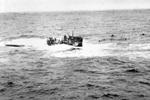GERMAN U-BOAT DISCOVERED OFF NEW ENGLAND COAST
by
Gary Kozak
July 28, 2012

Side Scan Sonar image of U-550 German Submarine

Photo mosaic image of German submarine U-550

Sinking of U-550 German Submarine
The WW II German submarine U-550 was discovered on July 23, 2012, 70 miles south of Nantucket Massachusetts. The U-550 was sunk by depth charges on April 16, 1944 after successfully torpedoing the American tanker, the Pan Pennsylvania. The exact location of the U-550 has never been known and though there have been several searches for the location of the U-550, all have been unsuccessful. Garry Kozak of EdgeTech, Wareham MA, is a specialist in undersea search with 40 years of experience. EdgeTech is a manufacturer of high resolution commercial & military side scan sonar systems used world wide for demanding undersea search operations. Garry teamed with AWS Expeditions operated by Joe Mazraani and associates to research and to finalize what should be the likely area the submarine sank in. Utilizing specialized side scan sonar large area search techniques, an area totaling over 70 square miles of seafloor were covered in 2 days of search operations resulting in the location of the U-550. The sonar image shows the U-550 sitting upright and tilting to her starboard side. Underwater images of the deck and torpedo loading hatch were captured and the images were assembled into a composite photo mosaic. Further documenting of the wreck site is planned.
Historical Background:
On April 16, 1944, the German submarine U-550, a type IXC/40 long-range U-boat under the command of Kaptitanleutnant Klaus Hanert, put a single torpedo into the stern of the 10,017-ton American tanker Pan Pennsylvania. The Allied tanker was in convoy and bound for England loaded with 140,000 barrels of gasoline at the time. Following the torpedo explosion, the ship took on an immediate list to port, and when a fire broke out in the engine room the tanker was abandoned in short order. The convoy escorts picked up 56 survivors, leaving 25 men missing out of a crew of 81. After picking up the survivors from the Pan Pennsylvania, the U.S. Navy destroyer escorts USS Joyce , Peterson and Gandy combined their efforts to bring swift and fatal retribution to the attacking submarine. Picking up a solid contact with her sonar gear, USS Joyce closed on the target and made a depth-charge attack that quickly brought the U-550 to the surface. Gunfire from all three escorts converged on the surfaced submarine as German sailors poured out of her hatches, briefly returning fire with their own weapons. Meanwhile, USS Gandy rammed the submarine aft and the Germans abandoned ship. A muffled explosion aboard the submarine indicated the crew had set off scuttling charges and U-550 sank stern first. Twelve survivors from the submarine were picked up by the destroyer escorts, while 44 men were lost. Patrol boats picked up the bodies of three German sailors outfitted with escape gear during the next several weeks: they had apparently escaped the sunken submarine only to die adrift at sea. The tanker Pan Pennsylvania capsized and drifted for two days, her cargo of gasoline on fire, before finally being sunk with gunfire.